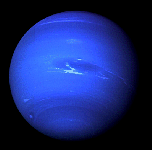Neptune
 The last of the giant planets, Neptune was first observed by multiple
observers including Adams, Galle, and Le Verrier in 1946. Like Uranus,
Neptune is made of fairly evenly distributed materials with no stratification.
Unlike the other planets, Neptune is made up of more ice and rock than
hydrogen, (15%� against Uranus’ 83%). It has a small rocky core with
a methane rich atmosphere which absorbs red light, giving Neptune its
appropriate deep sea blue colour. Neptune also has the fastest winds in
the Solar System, clocked at some 2000 miles per hour (3200km/h). Despite
its distance from the Sun, Neptune is incredibly hot, radiating back twice
the heat it receives from the Sun.
The last of the giant planets, Neptune was first observed by multiple
observers including Adams, Galle, and Le Verrier in 1946. Like Uranus,
Neptune is made of fairly evenly distributed materials with no stratification.
Unlike the other planets, Neptune is made up of more ice and rock than
hydrogen, (15%� against Uranus’ 83%). It has a small rocky core with
a methane rich atmosphere which absorbs red light, giving Neptune its
appropriate deep sea blue colour. Neptune also has the fastest winds in
the Solar System, clocked at some 2000 miles per hour (3200km/h). Despite
its distance from the Sun, Neptune is incredibly hot, radiating back twice
the heat it receives from the Sun.
Like Jupiter, Neptune has its own Great Spot. However, Neptune’s spot is only as big as Earth, half the size of the spot found on Jupiter, and far from stable. It can disappear from one hemisphere and reappear on the other. More permanent is the small spot on Neptune’s Southern Hemisphere and the small white cloud plume above it. This cloud zips around the planet in a regular way prompting scientists to give it the nickname “the scooter”.
|
Diameter |
49, 482 km |
|
Mass |
1.02 × 1026kg |
|
Mean Distance from sun |
4,504,300,000 km |
|
Mean Density |
1.64 g/cm3 |
|
Rotational Period |
0.66 Earth days |
|
Orbital Period |
164.8 Earth years |
|
Mean Orbital Velocity |
5.45 km/s |
|
Atmosphere |
79% hydrogen, 18% helium, 3% methane |
|
Average Surface Temperature |
-173°C |
|
Equatorial Surface Gravity |
11 m/s2 |
| Copyright owned by the State of Victoria (Department of Education and Early Childhood Development). Used with Permission. |
|
|||||||||||||||||||||||||||||||||||||||||||||||||||||||||||||||||||||||||||||||||||||